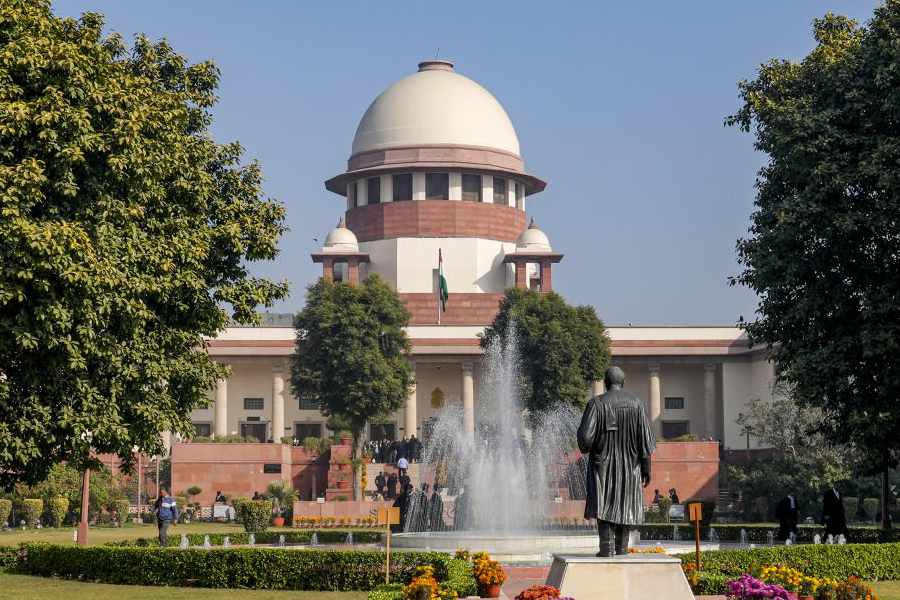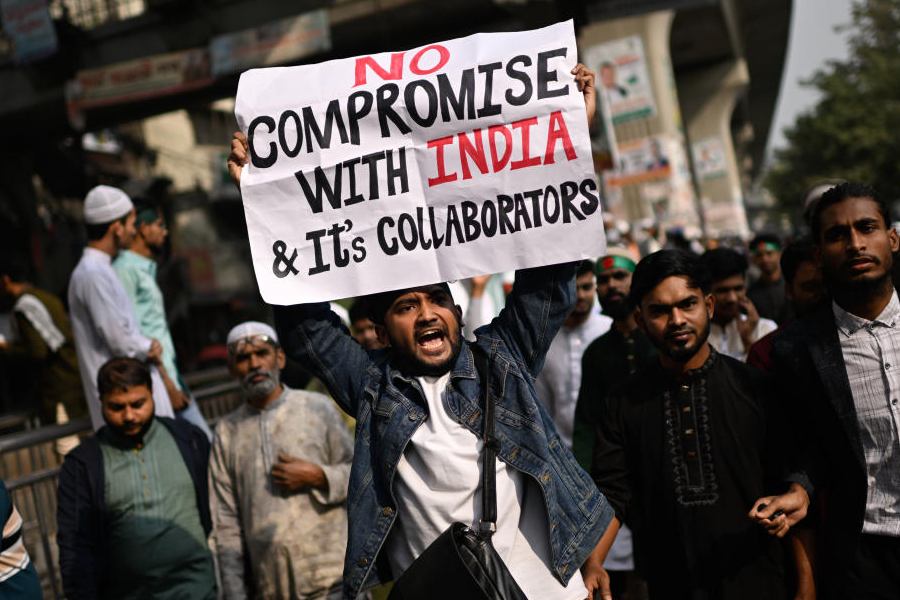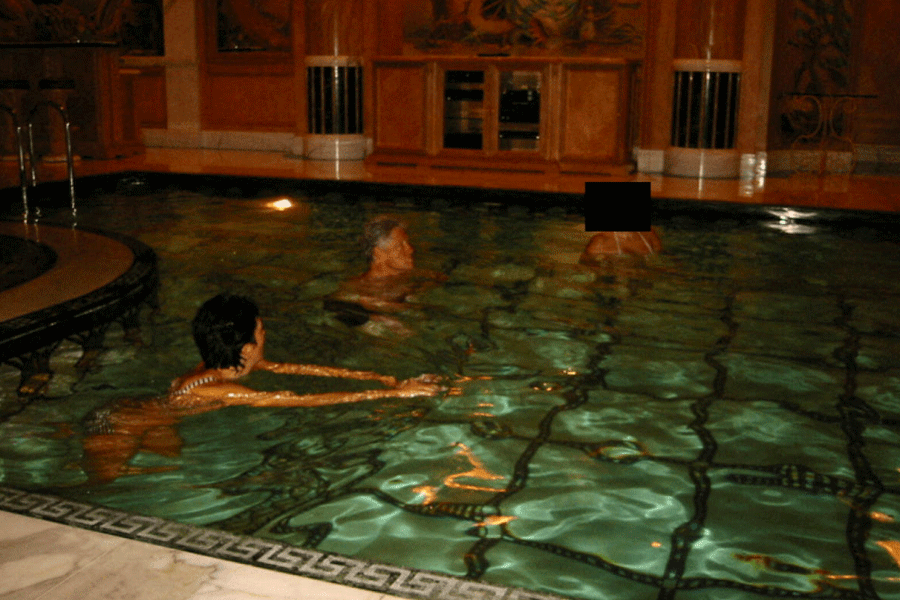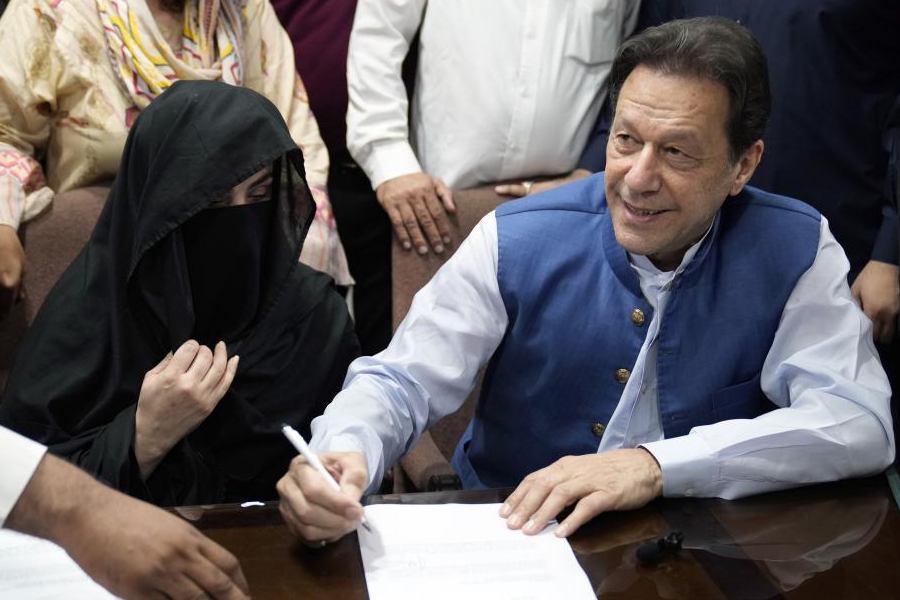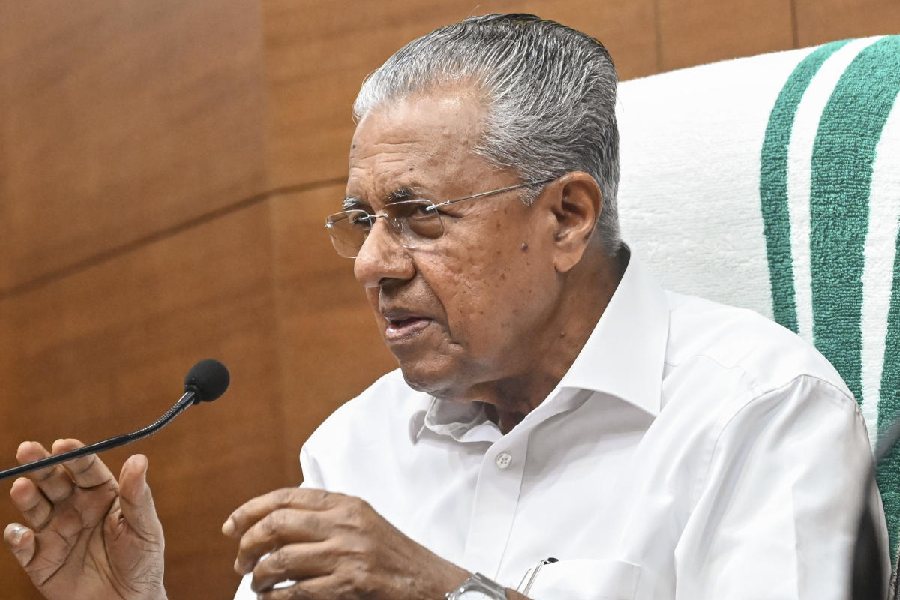Novelist Salman Rushdie once grumbled that he would always be known as, “the Indian writer, Salman...” Rushdie was provoked to make that comment after the saturation coverage lavished by the British media on another Indian who hit the headlines. That was Pamela Bordes, the lady who shot to instant fame in Britain after ‘going out’ with a string of British luminaries. Bordes, amazingly, quickly lost her ‘Indian’ tag overnight.
But Bordes was an ‘unusual’ exception to the rule. The fact is that Indians may take out American passports and develop a twangy delivery that’s never been heard in Ludhiana or Kumbakonam. They may have a string of degrees from Stanford or Harvard and a huge sprawling corner office with a great view. And, heck, they may even have millions stashed away in everything from banks to bonds and vast tracts of property.
But how many have lost the ‘Indian’ tag? The answer is very few. Only a handful of Indians have a globe-straddling reputation that turns them into citizens of the world. A reputation that’s so big that it evaporates their Third World origins. We’ve picked 10 Indians whose impact has been so great that they’ve been given honorary citizenship of the world.
 |
ZUBIN MEHTA
When Zubin Mehta turned 70 in April, he chose to mark the occasion with an autobiography written in, yes, German. The famed conductor was, till recently, the director of the Bavarian State Orchestra in Munich for almost eight years. And his musical journey began in Vienna, when he joined the Academy of Music at 18 after quitting the medical studies that his father, Mehli, wished him to pursue. As, Mehta, who was born on the first anniversary of the Bombay Symphony Orchestra founded by his father, once
recalled, “Every time I sat down to write an exam or cut up a dogfish, there I was with a Brahms symphony running through my head.”
So the scalpel gave way to the baton, much to the delight of music lovers. The flamboyant conductor, who never fails to pop open his silver box of red chillies at even gourmet meals in restaurants ? you can’t take the Indian out of the man ? has been a favourite with audiences, if not entirely with critics, over the years. And he has had many firsts to his credit.
For instance, he was the youngest conductor of the Vienna Philharmonic and Berlin Philharmonic. In 1962, at 26, he also became the youngest permanent conductor of the Los Angeles Philharmonic, a post he held till 1978. He was also the musical director of the New York Philharmonic for the longest tenure, from 1978 to 1991. And since 1981, he has been music director for life for the Israel Philharmonic. The Israel Philharmonic, incidentally, also celebrates its 70th anniversary this year. The maestro makes the most of his music with the Israel Philharmonic and the Orchestra del Maggio Musicale in Florence today, besides, of course, promoting the Mehli Mehta Music Foundation, set up in memory of his father, in Mumbai.
 |
AMARTYA SEN
When Amartya Sen won the Nobel Prize in 1998, press officers at Cambridge University were slightly flummoxed about their new star (Sen was Master of Trinity College, Cambridge at the time). “I’ve never actually met him,” said one harassed PR woman as she deflected queries from television stations and national newspapers.
That wasn’t terribly surprising. Amartya Sen ? who was named by Rabindranath Tagore ? is the quintessential academic and he looks and dresses the part. The Nobel Prize for economics was considered long overdue for a man who dabbles in everything from welfare and development economics to gender equality and moral and political philosophy. In fact, as writer and international bureaucrat Shashi Tharoor once wrote, Sen could “just as convincingly be described as a sociologist, historian, Sanskritist, political analyst and moral philosopher ?for starters”.
Two events left an everlasting impression on Sen. One was the 1943 Bengal famine, which later led to his seminal work on famines. The other was the death of a Muslim daily labourer, Kader Mia, during the Partition riots in Dhaka. Kader Mia’s death, said Sen, “made me aware of the dangers of narrowly defined identities”. It also resulted in his “development as freedom” theory, where he
argued that “economic unfreedom” could make a person prey to violations of other liberties.
Sen, who was born and studied at Santiniketan, revealed his brilliance early. He received one BA degree from Calcutta before heading to Trinity College, Cambridge for a second at 19. He raced through a PhD in a year but had to wait two years before it could be awarded. Meanwhile, he became the youngest economics professor at Jadavpur University. He then won a four-year fellowship to Cambridge, where he chose to study philosophy. Over the years, Sen, also a film and theatre buff, has taught at the world’s leading universities. And he still visits Santiniketan each winter, where he goes on long bicycle rides.
Economics, feels Sen, “is about understanding better the nature of the world ? the economic world, the social world and to some extent. the ethical world ? in which we live”. He has helped, in no small way, to promote that understanding.
 |
VINOD KHOSLA
Red Herring Magazine once described Vinod Khosla in superlative terms as, ‘the greatest venture capitalist on the planet’. But the Silicon Valley icon and venture capitalist came back to earth after the dotcom crash. He’s still a billionaire (just about) but had quite a rough time after 2000.
Today, the man who also co-founded Sun Microsystems is urging Californians to substitute gasoline with ethanol and is even backing a lobbying effort to tax oil production in the Sunshine State.
Back home in India, he’s championing micro-finance. Of course, Khosla has put his money where his mouth is. He quit Kleiner, Perkins, Caulfeld & Byers, the influential Silicon Valley venture capital firm, in 2004 and set up Khosla Ventures to spend more time with his four children and so he could invest in more “seed and speculative ventures”.
Now Khosla Ventures has invested in bio-fuel companies, Indian microfinance institutions and healthcare organisations like Aravind Eye Hospital. Khosla’s idea is to use Silicon Valley-style entrepreneurship skills to create “self-sustaining” organisations.
Khosla has always loved challenges. His reputation as a VC grew when he delivered hits such as Juniper Networks ? Kleiner Perkins reportedly made an over-1,000 times return on its invested capital in Juniper-Cerent, Siara Systems and NexGen.
Khosla, the son of an army officer, always wanted to be an entrepreneur. He has often told how he was inspired by leafing through Electrical Engineering Times during his IIT days in Delhi and reading about Intel. After graduating in electrical engineering, he even tried to start a soya milk company which quickly flopped. He then got a Masters degree in biomedical engineering from Carnegie Mellon, following by an MBA from Stanford. At Stanford he met Scott McNealy. The two, along with Andy Bechtolsheim of Carnegie Mellon and Bill Joy of Berkeley, founded Sun Microsystems in 1982. In 1986, Khosla quit Sun to move to Kleiner Perkins. He is still
interested in tech though, and has invested in companies like Beceem Communications, Xsigo Systems and Spatial Photonics.
 |
ANISH KAPOOR
Anish Kapoor’s creations seem to be growing in tandem with his reputation. In a few months at the Rockefeller Centre in New York, he’ll be unveiling Sky Mirror, an almost three-stories-tall circular sculpture that weighs 23 tonnes and is made of polished stainless steel. The intention is to reflect 30 Rockefeller Plaza “and turn it upside down”, he has said.
Two years ago, Kapoor installed Cloud Gate, nicknamed the Bean, at Millennium Park in Chicago. The $23-million 66-feet-long and 33-feet-high sculpture is made of a seamless series of highly polished stainless steel plates that reflect the Chicago skyline and the pedestrians below.
Kapoor, an ex-Doon School boy moved to Britain in 1972 when racism was at its height. He had a tough time initially, but in 1981 was taken on by the Lisson Gallery, one of the most powerful forces in the British art world. Since then he has never looked back. Kapoor won the Premio Duemila at the Venice Biennale in 1990 and the prestigious Turner Prize in 1991. And through the ‘90s, he has slaved away at his London workshop keeping regular hours and dreaming up ever bigger works.
Occasionally, he starts work on one creation and then leaves it lying around if he feels it isn’t working out right. As his reputation grows beyond Britain, he is getting commissions from around the world. Most interestingly, he has been commissioned to create an entire subway station in Naples as a work of art. There’s also a memorial to the British victims of 9/11 that he is working on.
In the early pieces, for instance, he used powdered pigment to cover the sculptures. In another series, he used quarried stone often carving out cavities in it. Since the 1990s, he has produced several large works like the 155-metre Marsyas with its red PVC membrane stretched over three gigantic steel rings in the huge Turbine Hall of the Tate Modern. He says that his sense of colour comes from his Indian background and experiences.
 |
LAKSHMI MITTAL
A funny thing happened to the world’s richest Indian this summer. After years of being the outsider who merely camped in Britain, Lakshmi Mittal suddenly found the British press cheering him on as he launched his audacious raid on Luxembourg’s Arcelor, the world’s second largest steelmaker. Mittal, who had been pilloried for his ostentatiously high-spending ways and for making donations to Britain’s Labour Party found he had become ? almost ? a hometown boy.
Whether, Arcelor slips out of his reach or not, it’s now obvious that Mittal has always been a few steps ahead of his rivals in the steel industry. When he upped sticks from Indonesia and moved to Britain 10 years ago, Mittal was an unknown in a highly unfashionable industry. But he was working to a clear gameplan and constantly adding to his empire.
In 2000, his plants around the world produced about
16mt of steel. Today, many takeovers later, that’s up to 70mt and he’s worth more than $20 billion. Whatever the critics may say, he has a golden touch and has upped production and turned rustbucket Communist-era plants into efficient money-spinners. Also, he has built up a strong position both in North America and Europe. And his plant in Kazakhstan, where the local KGB office also came with the steel mill, is a stone’s throw from China, which is ravenous for steel.
What’s left for Mittal? Well, he’s not very strong in Asia. And he has ignored India for years, but now that others like Pohang Steel are making big investments here, he’s showing much more interest. But, since many of his senior executives are from the Steel Authority of India, there are those who suggest he would be the right man to turn the state-run steelmaker into a mega-profit-maker. After all, the Indian giant would be a lot smaller than some of the companies he has taken over.
 |
HAR GOBIND KHORANA
It’s said that Har Gobind Khorana was so dedicated that he didn’t take a vacation for 12 years. Perhaps that was the tenacious dedication needed in his field of research. And, perhaps it was born of his early years of struggle.
After all, Har Gobind Khorana, who, with Marshal Nirenberg and Robert Holley, won the Nobel Prize for Medicine and Physiology in 1968 “for their interpretation of the genetic code and its function in protein synthesis” began his journey in a small village in Pre-Partition Punjab.
Credited with laying the building blocks of modern genetic engineering with his work in creating synthetic nucleic acids, Khorana was also the first to synthesise oligonucleotides or custom-designed pieces of artificial genes that are used for sequencing, cloning and engineering new plants and animals today.
Khorana was born in Raipur in 1922, the son of a patwari or tax collection officer. He studied first at home and then in Multan before moving to Punjab University at Lahore, where he did his B.Sc and M.Sc. He then went on a scholarship to do his Ph.D from the University of
Liverpool. Unfortunately when he returned to India in 1949, he found no takers for his research proposals or job applications. So he returned to England where he first began research into proteins and nucleic acids.
In 1952, Khorana, who is said to have enjoyed hiking in his younger days, and listening to music and who often found inspiration on his long daily walks, joined the University of British Columbia in Vancouver. In 1960, he moved to the Institute for Enzyme Research at the University of Wisconsin. Since 1970, Khorana has been the Alfred Sloan Professor of Biology and Chemistry, Emeritus, at the Massachusetts Institute of Technology.
 |
AMAR GOPAL BOSE
As a boy of 13 he fixed broken radios to supplement the family income. Today at 77, he rules the sound charts worldwide and heads a tech brand that’s trusted even more than Apple and Microsoft. Amar Gopal Bose, founder of the $1.8 billion Bose Corporation, has given the world a name to contend with in the arena of high-quality sound.
He’s taken Bose systems everywhere: to cars, homes, concert halls, the Sistine Chapel and NASA shuttles. He created the SoundDock speaker system for the pathbreaking iPod two years ago. He may have started life as an electrical engineer from the Massachusetts Institute of Technology (MIT), where he taught till 2000, but today he is ranked 645 in Forbes magazine’s 2006 rich list with a personal worth of $1.2 billion.
Bose grew up in Philadelphia, 20 miles from where Albert Einstein, a strong influence, lived. Bose’s father, a freedom fighter who escaped persecution by the British in Calcutta, landed at Ellis Island with $5 in his pocket in 1920. His turning point came in 1956 when he bought a stereo in 1956 and was disappointed by its sound quality. Bose Corporation was born in 1964, when the man set his heart to create speakers that would produce the sound of a live performance.
 |
SONNY MEHTA
He’s the man with the golden touch in the publishing industry. The man who took a presidential-sized gamble by paying a reported $10 million for Bill Clinton’s memoirs and whose writers include Garcia Marquez, Toni Morrison, Kazuo Ishiguro and Anne Rice. He’s also the man who Salman Rushdie once described as the “most laconic man in the universe”.
Sonny Mehta aka Ajai Singh Mehta, 63, is the chairman and editor-in-chief of Alfred A Knopf and he’s a larger-than-life and slightly enigmatic figure. He’s described as reserved and taciturn but with the ability to charm people. He is also known for his extravagant parties where writers like Marquez and V S Naipaul are likely to be spotted. His wife, by the way, is Gita Mehta, the well-known author of Karma Cola. She’s also the daughter of politician Biju Patnaik.
The son of a diplomat, Mehta, 63, studied at Cambridge, where he also met his wife. He worked at Picador and Pan Books in London through the 1970s and 1980s before moving to New York to take over as editor-in-chief of Knopf in 1987. He’s credited with making Vintage a highly successful paperback imprint and expanding the Knopf division by adding imprints such as the intellectually influential Pantheon and the Everyman’s Library classics line, and later, the Anchor paperback imprint.
More recently, Mehta has landed the rights to publish Bill Clinton’s second book, this time on “citizen activism and service”. This time most people are betting that the Clinton name still sells.
 |
C K PRAHALAD
When Coimbatore Krishnarao Prahalad speaks, big corporations listen. So, the corporate world is eagerly awaiting the management guru’s next book expected this fall. Of late, he’s been preaching that the most innovative corporate ideas will come from countries like India, China and Brazil.
The Paul and Ruth McCracken Professor of Corporate Strategy at the University of Michigan Ross Business School has propounded some of the biggest management ideas of the last 20 years. First, he talked about the need for multinationals to balance local demands and global vision in the 1980s. Then, came the concepts of core competency and strategic intent. More recently, he’s been talking about the market opportunity at the bottom of the pyramid and co-creation of value.
Prahalad who graduated at 19, worked with Union Carbide for four years. He did an MBA at Ahmedabad and then went to Harvard.
Among his seminal works are The Core Competence of the Corporation, and Competing for the Future, both written with Gary Hamel. And in his 2004 book, The Fortune at the Bottom of the Pyramid, he exhorted corporations to stop looking at the five-billion-odd poor people around the world as victims and identify them as a potential market instead.
 |
ARUN SARIN
In Britain it’s still unusual to find Indian executives at the top of the corporate heap. So, it’s all the more surprising that Arun Sarin vaulted to the top job at Vodafone Group plc, the biggest British corporation of them all.
Sarin may have inherited a bed of nails. Vodafone’s former chief executive Chris Gent grabbed every opportunity and turned the company into the world’s largest mobile phone company in the ‘90s. But he also spent heavily and left Sarin to clear up the mess.
So, Sarin’s in an unenviable position and every quarter he faces calls for his head from irate shareholders. Also, his route to the top at Vodafone has been somewhat unusual. He headed Vodafone AirTouch (Vodafone’s north American operations) till it was sold to Verizon Wireless. For a while, he was CEO of the overambitious, Seattle-based InfoSpace launched by Indian entrepreneur Naveen Jain, which collapsed after the dotcom boom.
Sarin, 52, is the son of an army officer and studied at an army boarding school in Bangalore. His mother discouraged him from joining the forces. So Sarin went to IIT Kharagpur and then to the University of California, Berkeley, where he met wife, Rummi.
Sarin’s also keen to expand Vodafone’s reach. But Vodafone’s financial woes have forced him to sell its businesses in Japan. He isn’t going to get much more time to perform a turnaround.


